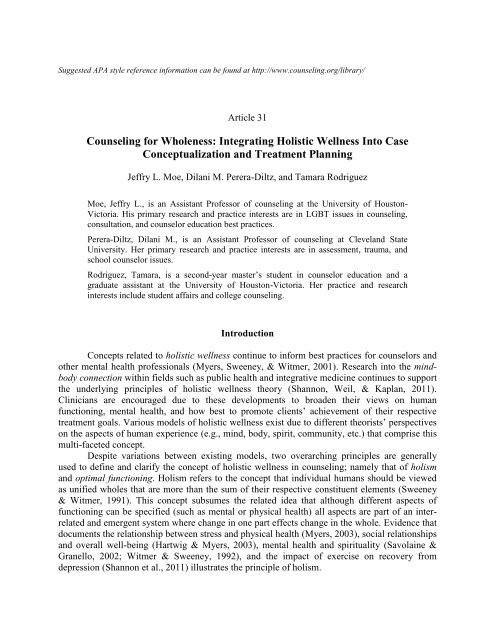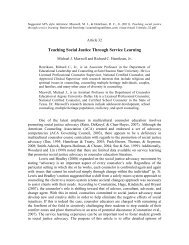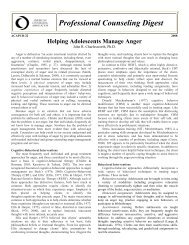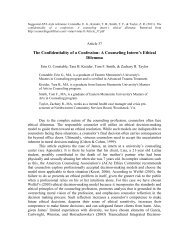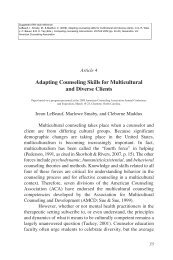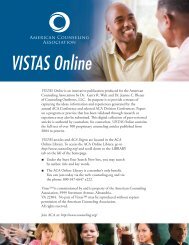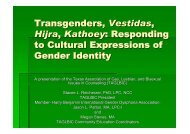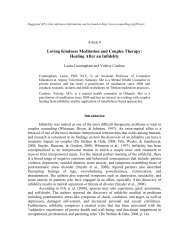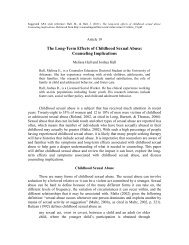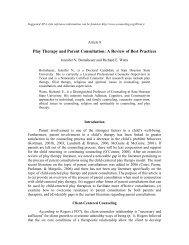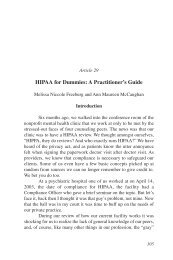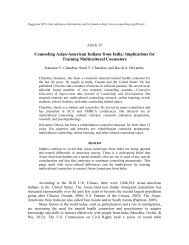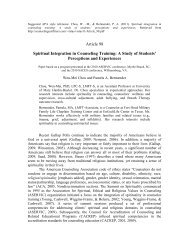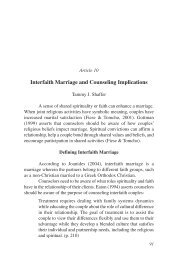Counseling for Wholeness - Counselingoutfitters.com
Counseling for Wholeness - Counselingoutfitters.com
Counseling for Wholeness - Counselingoutfitters.com
You also want an ePaper? Increase the reach of your titles
YUMPU automatically turns print PDFs into web optimized ePapers that Google loves.
Ideas and Research You Can Use: VISTAS 2012, Volume 1live a successful and healthy existence. Hettler theorized wellness as having six dimensions: a)physical, b) social, c) emotional, d) intellectual, e) occupational, and f) spiritual. Adherents ofHettler’s model stress the use of preventative physical self-care measures that people can engagein to prevent illness. Such measures include eating a healthy and balanced diet, exercise,avoiding or minimizing alcohol intake, and practicing breathing exercises designed to reducestress and tension levels (Hettler, 1984; Hermon & Hazler, 1999). These measures are alsoidentified as potential areas <strong>for</strong> treatment planning in counseling based on the Indivisible Selfframework (Myers, & Sweeney, 2005).The field of integrative medicine, which is based on the integration of both interventionist(i.e., allopathic) and <strong>com</strong>plementary (i.e., homeopathic) healthcare models, is also considered aholistic wellness approach (Shannon et al., 2011). An important philosophical contribution of theintegrative medicine paradigm involves not only preventing illness, but also the use of<strong>com</strong>plementary or even alternative healthcare strategies such as meditation to treat disorders.The incorporation of <strong>com</strong>plementary healthcare strategies is based on tapping into the strengths,values, and beliefs of clients as they cope with or over<strong>com</strong>e mild, moderate, or severe conditions(Shannon et al., 2011). According to Shannon et al. (2011) healthcare practice from theintegrative paradigm facilitates a broader and more <strong>com</strong>plete view of human health (includingmental health) and subsequently expands the available options that healthcare providers andclients can use to mitigate disorder and to promote resiliency.Multicultural ConsiderationsIn considering multicultural implications of the tenets of the existing wellness modelsrelated to counseling, a paradox exists. On the one hand it is important to not assume thegeneralizability of current wellness concepts as they were developed by and within the Western(-ized) social context. On the other hand wellness models based on the so-called mind-bodyspiritconnection are more consonant with indigenous healing practices and ideas of health foundin cultures around the globe (Yeh, Hunter, Madan-Bahel, Chiang, & Arora, 2004). Indigenoushealing techniques such as traditional Chinese medicine, yoga, Reiki healing, prayer, andmeditation are used to promote harmony and integration between different aspects of the humanself, including the spirit and relationships with others (Yeh et al., 2004). Many cultures share thebelief that various aspects of an individual (e.g., mind, body, soul, environment, etc.) must bealigned and in sync in order <strong>for</strong> a person to experience an ultimate sense of wellness (Garrett,Brubaker, Torres-Rivera, West-Olatunji, & Conwill, 2008; Yeh et al., 2004).There is evidence that holistic wellness models are applicable <strong>for</strong> conceptualizing theneeds of culturally diverse people. A positive correlation was documented (Rayle & Myers,2004) between ethnic identity and overall wellness in adolescents who belong to ethno-racialminority groups. Spirituality as an aspect of wellness was assessed directly and was found tosignificantly correlate to both overall wellness and to ethnic identity development <strong>for</strong> adolescentsfrom African-American backgrounds but not <strong>for</strong> European American adolescents (Rayle &Myers). In their conceptual article describing a group counseling technique designed inconcordance with Native American beliefs, Garrett et al. (2008) articulated how promotingharmony between different levels of experience (including the mind, spirit, relationships, andnature) is an essential <strong>com</strong>ponent of Native American views on health and wellness. It should benoted that Garrett et al. also asserted that the principle of harmony to promote wellness can beapplied to both clients from Native American backgrounds and to other clients. In a correlationbasedstudy Moe, Dupuy, and Laux (2008) found that lesbian, gay male, and bisexual3
Ideas and Research You Can Use: VISTAS 2012, Volume 1Assessment, Case Conceptualization, and Treatment PlanningMyers, Sweeney, and Witmer (2000) encouraged counselors to follow a four-phaseapproach when counseling from the Wheel of Wellness framework. The four phases include: a)introduction of the wellness model; b) assessment of wellness; c) designing and implementinginterventions; and d) evaluation and follow up. This four-phase model has been illustrated <strong>for</strong>work with adolescent offenders (Hartwig & Myers, 2003); to promote the self-care of individualsproviding care-giving to loved ones (Myers, 2003); and to promote psychological well-being andacademic achievement in primary school students (McLoughlin & Kubick, 2004). We extend thefour phase approach articulated by Myers et al. (2000) into the Indivisible Self framework todemonstrate how to integrate holistic wellness into case conceptualization and treatmentplanning during counseling with clients. The following phases can be initiated at either thebeginning of a new counseling relationship or within the context of an established relationship.Phase One: Orientation to WellnessIn the first phase of integrating wellness into counseling, clients are oriented to theIndivisible Self framework and to wellness in general (Myers et al., 2000). This begins with adiscussion of the wellness tenets of holism and optimal functioning with the goal of identifyingexamples of each that arise from the life and experience of the client. For example, clients can beasked if they have ever experienced a sense of connection between their mental and physicalhealth (holism) and in what ways their strengths help them cope with or even over<strong>com</strong>e stress(optimal functioning). Once it is determined that the client relates to the tenets of wellness it isimportant to introduce and explain the five factors and four contexts of the Indivisible Selfframework. It is not necessary to follow any specific order in discussing the <strong>com</strong>ponents of theIndivisible Self framework, and may be more useful if presented and discussed based on whatthe client is most likely to resonate with. It is also important to consider the impact of the fourcontexts (local, institutional, global, and chronometrical) in terms of how these influence thedefinitions of wellness that clients engage with over their lifespan. The following is a closer lookat the five domains of the Indivisible Self framework.The Essential Self. The Essential Self domain of the Indivisible Self framework includesspirituality, gender and cultural identities, and self care behaviors. Spirituality as conceived fromthe Indivisible Self framework includes the ability to ascribe and interpret life-events as havingmeaning (Savolaine & Granello, 2002), a sense of interconnectedness between oneself andothers, the possibility of the existence of a transcendent reality (i.e., sacredness or divinity), andmay also include the <strong>for</strong>mal practices related to organized religious affiliation (Myers et al.,2001). Reflection upon gender and cultural identities further improves the applicability of theIndivisible Self framework to work with diverse clients. Self-care behaviors include ef<strong>for</strong>tsundertaken by clients to achieve and maintain optimal functioning over the lifespan. Lack ofself-care behavior or lack of validating connections to spirituality, gender, and cultural identitiesmay result in feelings of hopelessness or purposelessness that attention to wellness conceptshelps to address (Myers & Sweeney, 2005).The Coping Self. The Coping Self domain incorporates: a) holding realistic beliefs, b)stress management strategies, c) a sense of self-worth, and d) leisure activities that promote asense of fun and enjoyment. The Essential Self is distinct from the Coping Self as the <strong>for</strong>mer isconceived as aspects of self-identity and the latter as discrete sets of coping skills individuals useon a day-to-day basis (Myers & Sweeney, 2005). Threats to the <strong>com</strong>ponents of the Essential Selfare more likely to be experienced as crises, while lack of attention to the Coping Self could lead5
Ideas and Research You Can Use: VISTAS 2012, Volume 1developed to assess strengths and areas <strong>for</strong> growth within each domain and sub-domain of theIndivisible Self framework. An interview protocol based on exploring the domains of theIndivisible Self could also be used; Myers (2003) re<strong>com</strong>mends using scaling questions to bothfacilitate client self-assessment of wellness and to begin identifying actions the client can take toimprove wellness in a specific domain and thereby the client’s overall level of wellness.Phase Three: Wellness PlanningOnce the results of <strong>for</strong>mal and in<strong>for</strong>mal assessment are shared, clients may be tempted towork on all growth areas where dissatisfaction is experienced. Facilitating client focus on a fewareas of growth is the wellness-based counterpart to the diagnosis of mental disorder; rather thanrestoring functioning and remediating symptoms, however, the wellness plan seeks to improveunder-developed strengths and assets based on the belief that change in one area of the client’slevel of capacity improves the client’s overall functioning (Myers, 2003; Myers & Sweeney,2005). Wellness interventions would vary depending on the areas chosen <strong>for</strong> improvement, andthe role of the counselor shifts during this phase to include motivating the client to followthroughon selected wellness-promoting strategies. Actions taken outside of the counselingsession be<strong>com</strong>e the focus of dialogue, and may even include advocacy to change institutionalpolicies or improve access to resources related to clients’ ability to achieve and promote theirown and others’ holistic wellness across salient social contexts.Phase Four: Evaluation and Follow-UpOnce areas are identified and interventions are set in motion, it is useful to evaluateprogress using scaling in order to facilitate continued motivation. New issues may arise as clientsengage in their identified wellness plan, and a shift in goals may be necessary as clients integratetheir wellness strategies into their overall concept of self-in-relation to local, institutional, global,and chronometric contexts. It is important to highlight <strong>for</strong> clients how their attainment ofwellness goals facilitated positive growth across the domains of their life, including anysymptom relief or resolution experienced directly or indirectly as a result. Counselors should alsopay attention to when and if the client has begun to continuously engage in wellness strategies;this could be a sign that the wellness integration itself was successful and may also serve as amarker <strong>for</strong> the termination of the counseling relationship. Structured follow-up should include aperiod of reflection <strong>for</strong> both the counselor and the client, and questions related to how values,beliefs, and definitions of holistic wellness continued to evolve are important to consider bothindividually and collaboratively. This phase is an important time <strong>for</strong> counselors to reflect upontheir own <strong>com</strong>mitment to holistic wellness, both as a treatment approach <strong>for</strong> clients and in termsof application to counselors’ own lives.Case ExampleIn order to further illustrate the approach described above, consider the case of a clientwho is beginning her tenure track career as a counselor educator. The counselor educator seeksprofessional counseling due to feelings of stress that seem at times overwhelming. The counselorinitiates a conversation about holistic wellness and both client and counselor agree to engage inexploration of the client’s wellness within the Indivisible Self framework. During phase one, thecounselor would provide knowledge of the Indivisible Self domains, sub-domains, and contexts7
Ideas and Research You Can Use: VISTAS 2012, Volume 1of experience. This includes discussing the meaning of each domain, examples from the client’sown life, and clarifying concepts that seem novel to the client.In the assessment phase, the counselor and client explore how the client is currentlyfunctioning within each domain and sub-domain across the four contexts specified above. Thecounselor uses scaling questions to help the client identify areas of strength and of developmentacross the domains of the Indivisible Self. High and low points are agreed upon, and the clientidentifies being satisfied with functioning in domains of the Physical Self, Essential Self, andSocial Self across multiple levels of context. The client articulates that her sense of connection toothers, her exercise routine, and her personal spiritual beliefs are and will be sources of strengthshe draws from to support her <strong>com</strong>mitment to improving wellness in other areas.Two important areas of growth <strong>for</strong> the client include sense of control (Creative Self)within the institutional context and stress management within both family (i.e., local) andinstitutional settings (Coping Self). The counselor and client collaboratively agree to explorestress management techniques with the knowledge that improvement in stress management willimpact the client’s overall wellness. The counselor and client practice guided imagery techniquesthe client can use at work, how to voice doubts and concerns with family members, deepbreathing techniques, and how to self-affirm when small goals are met along the way towardsrealizing long-range goals like publishing a manuscript or submitting final grades <strong>for</strong> a course.Success implementing these strategies is scaled in an ongoing manner, and the counselor alsouses scaling questions to assess improvement in other domains to rein<strong>for</strong>ce the wellness principleof holism. The improvement in wellness can be used to clarify whether the counselingrelationship should be terminated, or can continue to be referenced in support of the client shouldother areas <strong>for</strong> improvement be<strong>com</strong>e the focus of the relationship.ConclusionDesigning and planning interventions within this four-phase model facilitates theintroduction of holistic wellness into case conceptualization and treatment planning with clients.The elements of the Indivisible Self framework represent <strong>com</strong>ponents of holistic wellnessidentified as important across disciplines, of particular import <strong>for</strong> professional counselors, andthat are supported by empirical evidence (Harari, Waehler, & Rogers, 2005; Myers & Sweeney,2005). Expanding one’s view of health and functioning to include holistic wellness af<strong>for</strong>dscounselors increased opportunities <strong>for</strong> case-conceptualization and treatment planning. Wellnessas it applies to working with minority cultures and marginalized populations is an area in need ofmore theorizing and empirical work. Trends toward validation of the mind-body connection(Shannon et al., 2011) across cultures and contexts ensures that the philosophy of holisticwellness will remain relevant <strong>for</strong> counselors seeking to facilitate client achievement of optimal,holistic, and personally-meaningful functioning over the lifespan and across the domains ofmind, body, spirit, and <strong>com</strong>munity.ReferencesAnsbacher, H., & Ansbacher, R. (Eds.). (1956). The individual psychology of Alfred Adler. NewYork, NY: Basic Books, Inc.Dunn, H. (1961). High level wellness. Arlington, VA: R. W. Beatty.8
Ideas and Research You Can Use: VISTAS 2012, Volume 1Garrett, M., Brubaker, M., Torres-Rivera, E., West-Olatunji, C., & Conwill, W. (2008). Themedicine of <strong>com</strong>ing to center: Use of the Native American Centering Technique—Ayeli—to promote wellness and healing in group work. Journal <strong>for</strong> Specialists in GroupWork, 33, 179-198.Harari, M., Waehler, C., & Rogers, J. (2005). An empirical investigation of a theoretically basedmeasure of perceived wellness. Journal of <strong>Counseling</strong> Psychology, 52, 93-103.Hartwig, H., & Myers, J. (2003). A different approach: Applying a wellness paradigm toadolescent female delinquents and offenders. Journal of Mental Health <strong>Counseling</strong>, 25,57-75.Hattie, J., Myers, J., & Sweeney, T. (2004). A factor structure of wellness: Theory, assessment,analysis, and practice. Journal of <strong>Counseling</strong> & Development, 82, 354-364.Hermon, D., & Hazler, R. (1999). Adherence to a wellness model and perceptions ofpsychological well-being. Journal of <strong>Counseling</strong> & Development, 77, 339-343.Hettler, B. (1984). Wellness: Encouraging a lifetime pursuit of excellence. Health Values:Achieving High Level Wellness, 8, 13-17.Makinson, L., & Myers, J. (2003). Wellness: An alternative paradigm <strong>for</strong> violence prevention.Journal of Humanistic <strong>Counseling</strong>, Education & Development, 42, 165-177.McLoughlin, C., & Kubick, R. (2004). Wellness promotion as a life-long endeavor: Promotingand developing life <strong>com</strong>petencies from childhood. Psychology in the Schools, 41, 131-141.Moe, J., Dupuy, P., & Laux, J. (2008). The relationship between LGBQ identity developmentand hope, optimism, and life engagement. Journal of LGBT Issues in <strong>Counseling</strong>, 2, 199-215.Myers, J. (1992). Wellness, prevention, development: The cornerstone of the profession. Journalof <strong>Counseling</strong> & Development, 7, 136.Myers, J. (2003). Coping with care giving stress: A wellness-oriented, strengths-based approach<strong>for</strong> family counselors. The Family Journal: <strong>Counseling</strong> & Therapy <strong>for</strong> Couples &Families, 11, 153-161.Myers, J., Mobley, K., & Booth, C. (2003). Wellness of counseling students: Practicing what wepreach. Counselor Education & Supervision, 42, 264-274.Myers, J. E., & Sweeney, T. J. (2005). The Indivisible Self: An evidence-based model ofwellness (reprint). Journal of Individual Psychology, 61, 269-279.Myers, J. E., Sweeney, T. J., & Witmer, M. (2000). The wheel of wellness, counseling <strong>for</strong>wellness: A holistic model <strong>for</strong> treatment planning. Journal of <strong>Counseling</strong> andDevelopment, 78, 251-266.Myers, J., Sweeney, T., & Witmer, J. M. (2001). Optimization of behavior: Promotion ofwellness. In D. Locke, J. Myers, & E. Herr (Eds.), The handbook of counseling, (pp. 641-652). Thousand Oaks, CA: Sage.Rayle, A., & Myers, J. E. (2004). <strong>Counseling</strong> adolescents toward wellness: The Roles of ethnicidentity, acculturation, and mattering. Professional School <strong>Counseling</strong>, 8, 81-90.Remley, T. P., Jr., & Herlihy, B. (2001). Ethical, legal, and professional issues in counseling.Upper Saddle River, NJ: Prentice-Hall.Savolaine, J., & Granello, P. (2002). The function of meaning and purpose <strong>for</strong> individualwellness. Journal of Humanistic <strong>Counseling</strong>, Education & Development, 41, 178-189.9
Ideas and Research You Can Use: VISTAS 2012, Volume 1Shannon, S., Weil, A., & Kaplan, B. J. (2011). Medical decision making in integrative medicine:Safety, efficacy, and patient preference. Alternative & Complementary Therapies, 17, 84-91. doi:10.1089/act.2011.17210Sweeney, T., & Witmer, J. M. (1991). Beyond social interest: Striving towards optimum healthand wellness. Individual Psychology: The Journal of Adlerian Theory, Research, andPractice, 47, 527-540.Witmer, J. M., & Sweeney, T. (1992). A holistic model <strong>for</strong> wellness and prevention over the lifespan. Journal of <strong>Counseling</strong> & Development, 71, 140-148.Witmer, J. M., & Young, M. (1996). Preventing counselor impairment: A wellness approach.Journal of Humanistic <strong>Counseling</strong>, Education, & Development, 34, 141-153.Yeh, C., Hunter, C., Madan-Bahel, A., Chiang, L., & Arora, A. (2004). Indigenous andinterdependent perspectives of healing: Implications <strong>for</strong> counseling and research. Journalof <strong>Counseling</strong> & Development, 82, 410-419.Note: This paper is part of the annual VISTAS project sponsored by the American <strong>Counseling</strong> Association. Findmore in<strong>for</strong>mation on the project at: http://counselingoutfitters.<strong>com</strong>/vistas/VISTAS_Home.htm10


